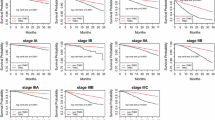Abstract
Biopsies of metastatic tissue are increasingly being performed. Bone is the most frequent site of metastasis in breast cancer patients, but bone remains technically challenging to biopsy. Difficulties with both tissue acquisition and techniques for analysis of hormone receptor status are well described. Bone biopsies can be carried out by either by standard posterior iliac crest bone marrow trephine/aspiration or CT-guided biopsy of a radiologically evident bone metastasis. The differential yield of these techniques is unknown. Results from three prospective studies of similar methodology were pooled. Patients underwent both an outpatient posterior iliac crest bone marrow trephine/aspiration and a CT-guided biopsy of a radiologically evident bone metastasis. Samples were assessed for the presence of malignant cells and where possible also for estrogen (ER) and progesterone receptor (PgR) expression. 40 patients were enrolled. Bone marrow aspiration/trephine biopsy was completed in 39/40 (97.5%) and CT-guided biopsy was completed in 34/40 (85%) of patients. Sufficient tumor cells for hormone receptor analysis were available in 19/39 (48.8%) and 16/34 (47%) of and bone marrow aspiration/trephine and CT-guided biopsies, respectively. Significant discordance in ER and PgR between the primary and the bone metastasis was also seen. Nine patients had tissue available from both bone marrow and CT-guided bone biopsies. ER and PgR concordance between these sites was 100 and 78%, respectively. Performing studies on human bone metastases is technically challenging, with relatively low yields regardless of technique. Given resource issues and similar success rates when comparing both techniques, bone marrow examination may be utilized first and if inadequate tissue is obtained, CT-guided biopsies can then be used.
Similar content being viewed by others
Abbreviations
- ER:
-
Estrogen receptor
- PgR:
-
Progesterone receptor
- HER2:
-
Human epidermal growth factor receptor 2
- IHC:
-
Immunohistochemistry
- FISH:
-
Fluorescent in-situ hybridization
References
Amir E, Clemons M (2009) Should a biopsy be recommended to confirm metastatic disease in women with breast cancer? Lancet Oncol 10:933–935
Amir E, Clemons M, Freedman OC, Miller NR, Coleman RE, Purdie C, Jordan L, Quinlan P, Thompson AM (2010)Tissue confirmation of disease recurrence in patients with breast cancer: pooled analysis of two large prospective studies. J Clin Oncol 228:s1007
Locatelli MA, Curigliano G, Fumagalli L, Bagnardi V, Aurilio G, Della Vigna P, Monfardini L, Giudici S, Viale G, Goldhirsch A (2010) Should liver metastases of breast cancer be biopsied to improve treatment choice? J Clin Oncol 28:s1008
Karlsson E, Lindström LS, Wilking U, Skoog L, Johansson U, Bergh J (2010) Discordance in hormone receptor status in breast cancer during tumor progression. J Clin Oncol 28:s1009
Simmons C, Miller N, Geddie W, Gianfelice D, Oldfield M, Dranitsaris G, Clemons MJ (2009) Does confirmatory tumor biopsy alter the management of breast cancer patients with distant metastases? Ann Oncol 20:1499–1504
Broom RJ, Tang PA, Simmons C, Bordeleau L, Mulligan AM, O’Malley FP, Miller N, Andrulis IL, Brenner DM, Clemons MJ (2009) Changes in estrogen receptor, progesterone receptor and Her-2/neu status with time: discordance rates between primary and metastatic breast cancer. Anticancer Res 29:1557–1562
Lower EE, Glass EL, Bradley DA, Blau R, Heffelfinger S (2005) Impact of metastatic ER and PR status on survival. Breast Cancer Res Treat 90:65–70
Lipton A, Leitzel K, Ali SM, Demers L, Harvey HA, Chaudri-Ross HA, Evans D, Lang R, Hackl W, Hamer P, Carney W (2005) Serum HER-2/neu conversion to positive at the time of disease progression in patients with breast carcinoma on hormone therapy. Cancer 104:257–263
Regitnig P, Schippinger W, Lindbauer M, Samonigg H, Lax SF (2004) Change of HER-2/neu status in a subset of distant metastases from breast carcinomas. J Pathol 203:918–926
Li BD, Byskosh A, Molteni A, Duda RB (1994) Estrogen and progesterone receptor concordance between primary and recurrent breast cancer. J Surg Oncol 57:71–77
Mobbs BG, Fish EB, Pritchard KI, Oldfield G, Hanna WH (1987) Estrogen and progesterone receptor content of primary and secondary breast cancer: influence of time and treatment. Eur J Cancer Clin Oncol 23:819–826
Raemaekers JM, Beex LV, Koenders AJ, Pieters GF, Smals AG, Benraad TJ, Kloppenborg PW (1984) Concordance and discordance of estrogen and progesterone receptor content in sequential biopsies of patients with advanced breast cancer: relation to survival. Eur J Cancer Clin Oncol 20:1011–1018
Holdaway IM, Bowditch JV (1983) Variation in receptor status between primary and metastatic breast cancer. Cancer 52:479–485
Hull DF, Clark GM, Osborne CK, Chamness GC, Knight WA III, McGuire WL (1983) Multiple estrogen receptor assays in human breast cancer. Cancer Res 43:413–416
Coleman RE (1997) Skeletal complications of malignancy. Cancer 80:1588–1594
Cawthorn TR, Amir E, Broom R, Freedman O, Gianfelice D, Barth D, Wang D, Holen I, Done SJ, Clemons M (2009) Mechanisms and pathways of bone metastasis: challenges and pitfalls of performing molecular research on patient samples. Clin Exp Metastasis 26:935–943
Amir E, Miller N, Geddie W et al (2010) Can bone biopsies be used to confirm metastatic disease recurrence and receptor status in breast cancer patients? In: 10th International Conference. Cancer-induced bone disease, 22–25 September, Sheffield, UK, Abstract P16
Diaz LK, Sneige N (2005) Estrogen receptor analysis for breast cancer: current issues and keys to increasing testing accuracy. Adv Anat Pathol 12:10–19
Acknowledgments
Funding for this study was provided by The Ottawa Cancer Research Foundation and the “Tina and her Angels of Hope Fund”.
Conflict of interest
None.
Author information
Authors and Affiliations
Corresponding author
Rights and permissions
About this article
Cite this article
Hilton, J.F., Amir, E., Hopkins, S. et al. Acquisition of metastatic tissue from patients with bone metastases from breast cancer. Breast Cancer Res Treat 129, 761–765 (2011). https://doi.org/10.1007/s10549-010-1264-6
Received:
Accepted:
Published:
Issue Date:
DOI: https://doi.org/10.1007/s10549-010-1264-6




